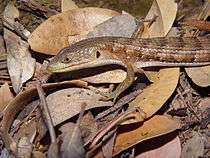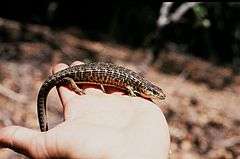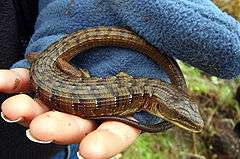Northern alligator lizard
| Northern alligator lizard | |
|---|---|
 | |
| Scientific classification | |
| Kingdom: | Animalia |
| Phylum: | Chordata |
| Subphylum: | Vertebrata |
| Class: | Reptilia |
| Order: | Squamata |
| Suborder: | Sauria |
| Infraorder: | Anguimorpha |
| Family: | Anguidae |
| Subfamily: | Gerrhonotinae |
| Genus: | Elgaria |
| Species: | E. coerulea |
| Binomial name | |
| Elgaria coerulea (Wiegmann, 1828) | |
| Synonyms[1] | |
| |
The northern alligator lizard (Elgaria coerulea) is a medium-sized lizard that occurs on the North American west coast.
Taxonomy
The northern alligator lizard was formerly known by the scientific name of Gerrhonotus coeruleus Wiegmann, 1828, but is nowadays assigned to the genus Elgaria.
Four subspecies are recognized as being valid, including the nominotypical subspecies:
- E. c. coerulea (Wiegmann, 1828) – San Francisco alligator lizard
- E. c. palmeri (Stejneger, 1893) – Sierra alligator lizard
- E. c. principis Baird & Girard, 1852 – Northwestern alligator lizard
- E. c. shastensis (Fitch, 1934) – Shasta alligator lizard
Nota bene: A trinomial authority in parentheses indicates that the subspecies was originally described in a genus other than Elgaria.
The subspecies E. c. principis is one of five species of lizards in Canada.
Etymology
The subspecific name, palmeri, is in honor of American zoologist Theodore Sherman Palmer.[2]
Description
Sierra alligator lizards are medium-sized slender lizards. Adults reach a snout-to-vent length of about 10 cm (3.9 in) and a total length of roughly 27.5 cm (10.8 in). They have a distinct skin fold on their sides, separating the keeled scales on the back from the smooth ventral scales. This skin varies in color, but can be brown and white or greenish yellow and brown. They are brownish in color and often have dark blotches that sometimes blend together into bands. The throat and mouth area of some young individuals can be yellow. The belly is light gray. The eyes are dark. Their typical diet includes crickets, mealworms, and moths, but they will also take larger prey, such as small lizards, and will even eat small baby mice if given the opportunity.
Reproduction
The Northern Alligator Lizard is live-bearing, producing up to 15 young (typically 4–5), between June and September.[3] During the spring breeding season, a male lizard grabs on to the head of a female with his mouth until she is ready to let him mate with her. They can remain attached this way for many hours, almost oblivious to their surroundings. Besides keeping her from running off to mate with another male, this probably shows her how strong and suitable a mate he is.[4]



Distribution
 |
Ranges of
|
The Northern alligator lizard occurs along the Pacific Coast and in the Rocky Mountains from southern British Columbia through Washington, northern Idaho and western Montana south through Oregon to the coastal range and the Sierra Nevada in central California. As the map shows, the different subspecies have quite different ranges, with E. c. principis being the most widely distributed, whereas the E. c. coerulea subspecies occurs mainly around the San Francisco area but they are also found farther north into Humboldt County.
The species is widely distributed along the Pacific coast and can be found from sea level up to elevation of about 3,350 m (10,990 ft). It is found in a variety of forested habitats and montane chaparral.
See also
References
- ↑ "Elgaria coerulea ". The Reptile Database. www.reptile-database.org.
- ↑ Beolens B, Watkins M, Grayson M (2011). The Eponym Dictionary of Reptiles. Baltimore: Johns Hopkins University Press. xiii + 296 pp. ISBN 978-1-4214-0135-5. (Elgaria coerulea palmeri, p. 200).
- ↑ Stebbins RC (2003). A Field Guide to Western Reptiles and Amphibians, Third Edition. The Peterson Field Guide Series ®. Boston and New York: Houghton Mifflin Company. xiii + 533 pp. ISBN 978-0-395-98272-3. (Elgaria coerulea, pp. 332-333 + Plate 41 + Map 126).
- ↑ http://www.californiaherps.com/lizards/pages/e.c.principis.html
Further reading
- Boulenger GA (1885). Catalogue of the Lizards in the British Museum (Natural History). Second Edition. Volume II. ... Anguidæ ... London: Trustees of the British Museum (Natural History). (Taylor and Francis, printers). xiii + 497 pp. + Plates I-XXIV. (Gerrhonotus cæruleus, pp. 273-274).
- Wiegmann AF (1828). "Beiträge zur Amphibienkunde ". Isis von Oken 21 (4): 364-383. (Gerrhonotus coeruleus, new species, p. 380). (in German and Latin).
External links
| Wikimedia Commons has media related to Elgaria coerulea. |
- Images from Californiaherps.com
- Description and range map from the California Department of Fish and Game.
- Taxonomical Information
- Description, photos, and information from the British Columbia Ministry of Environment